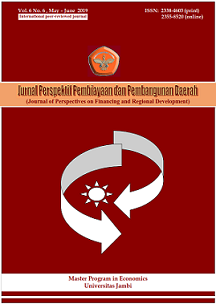Impact of population growth on Carbon Dioxide (CO2) emission: empirical evidence from Nigeria
DOI:
https://doi.org/10.22437/ppd.v6i6.6730Abstract
This paper seeks to examine the impact of population growth on carbon dioxide emission in Nigeria. Time series data from 1975 to 2016 was adopted. Variables such as population, affluence and technology were used as independent variables which were extracted from the IPAT equation. Econometric tools such as Ordinary Least Squares were adopted. The findings show that there is a positive association between CO2 emission, population and technology whereas affluence has a negative relationship with CO2. The study concluded that the population growth has a marginal impact on the level of CO2 emission. The paper recommended that there is need for the government to adopt a climate friendly technology that will minimize the increasing CO2 emission, improve on its GDP alongside controlling her population growth.
Downloads
References
Behera, B., & Vishnu, R.( 2011). Analyzing the Impact of Anthropogenic Factors on the Environmnet in India. Environment and Natural Resources Research, 1(1), 1-13.
Bruvoll, A., & Medin, H. (2003). Factors behind the environmental Kuznets curve : a decomposition of the changes in air pollution. Environmental and resource economics, 24 (1), 27-48
Cole, M.A., & Neumayer, E. (2004). Examining the Impact of Demographic Factors Countries. Energy Policy, 30, 63-71.
Dictionary.com. (2018). Carbon dioxide. Retrieved November 22, 2018 from https://www.dictionary.com/browse/carbon-dioxide.
Ehrlich, R. Paul. (1968). The Population Bomb. New York: Ballantine.
Engleman, R. (1994). Stabilizing the Atmosphere: Population, Consumption, Greenhouse Gases. Washington, D.C.: Population Action International.
Field, A.P. (2009). Discovering Statistics using SPSS: and sex and drugs and rock “n†roll (3rd edition). London: Sage
Gregory C., & Oded G. (2016). Population Growth and Carbon Emissions. NBER Working Paper Series; National Bureau of Economic Research 1-34
Hamilton, C., & Turton, H. (2002). Determinants of Emissions Growth in OECD countries’ Energy Policy, 30, 63-71.
Holdren, J.P., & Paul R. E.(1974). Human Population and the Global Environment. American Scientist, 62, 282-292.
Inmaculada, A & Rafael. (2006).The Impact of Population on CO2 Emissions: Evidence from European Countries. The Fondazione Eni Enrico Mattei Note di Lavoro Series Index, 1-32.
Janssens-Maenhout, G., Crippa, M., Guizzardi, D., Muntean, M., Schaaf, E., Olivier, J.G.J., Peters, J.A.H.W., & Schure, K.M. (2017). Fossil CO2 and GHG emissions of all world countries. Luxembourg: Publications Office of the European Union
MartÃnez-Zarzoso, I. & Bengochea-Morancho, A. (2004). Testing for Environmental Kuznets Curves For CO2: Evidence from Pooled Mean Group Estimates, Economic Letters 82 (1), 121-126.
Sanglimsuwan, K (2012).The Impact of Population pressure on Carbon dioxide emission: Evidence from panel-econometric analysis. International Research Journal of Finance and Economics, 82, 82-94.
Scientificamerican.( 2018). Does Population Growth Impact Climate Change. Retrieved November 21, 2018 from https://www.scientificamerican.com/article/population-growth-climate-change.
Shi, A.( 2003).The Impact of population pressure on global carbon dioxide emissions, 1975-1996: evidence from pooled cross-country data. Ecological Economics, 44, 29-42.
Stern, D.I. (1998). Progress on the Environmental Kuznets Curve? Environmental and Development Economics ,3, 173-196.
Worldometer (2018). World Population by Year. Retrieved November 11, 2018 from www.worldometers.info/world-population/world-population-by-year
Downloads
Published
How to Cite
Issue
Section
License
Copyright (c) 2019 Ibrahim Mohammed Lawal

This work is licensed under a Creative Commons Attribution 4.0 International License.

















